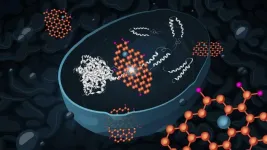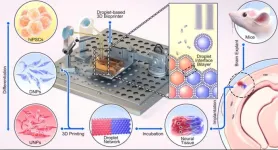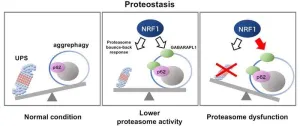(Press-News.org) A probable early driver of Alzheimer's disease is the accumulation of molecules called amyloid peptides. These cause cell death, and are commonly found in the brains of Alzheimer’s patients. Researchers at Chalmers University of Technology, Sweden, have now shown that yeast cells that accumulate these misfolded amyloid peptides can recover after being treated with graphene oxide nanoflakes.
Alzheimer’s disease is an incurable brain disease, leading to dementia and death, that causes suffering for both the patients and their families. It is estimated that over 40 million people worldwide are living with the disease or a related form of dementia. According to Alzheimer’s News Today, the estimated global cost of these diseases is one percent of the global gross domestic product.
Misfolded amyloid-beta peptides, Aβ peptides, that accumulate and aggregate in the brain, are believed to be the underlying cause of Alzheimer’s disease. They trigger a series of harmful processes in the neurons (brain cells) – causing the loss of many vital cell functions or cell death, and thus a loss of brain function in the affected area. To date, there are no effective strategies to treat amyloid accumulation in the brain.
Researchers at Chalmers University of Technology have now shown that treatment with graphene oxide leads to reduced levels of aggregated amyloid peptides in a yeast cell model.
“This effect of graphene oxide has recently also been shown by other researchers, but not in yeast cells”, says Xin Chen, Researcher in Systems Biology at Chalmers and first author of the study. “Our study also explains the mechanism behind the effect. Graphene oxide affects the metabolism of the cells, in a way that increases their resistance to misfolded proteins and oxidative stress. This has not been previously reported.”
Investigating the mechanisms using baker’s yeast affected by Alzheimer’s disease
In Alzheimer’s disease, the amyloid aggregates exert their neurotoxic effects by causing various cellular metabolic disorders, such as stress in the endoplasmic reticulum – a major part of the cell, in which many of its proteins are produced. This can reduce cells’ ability to handle misfolded proteins, and consequently increase the accumulation of these proteins.
The aggregates also affect the function of the mitochondria, the cells’ powerhouses. Therefore, the neurons are exposed to increased oxidative stress (reactive molecules called oxygen radicals, which damage other molecules); something to which brain cells are particularly sensitive.
The Chalmers researchers have conducted the study by a combination of protein analysis (proteomics) and follow-up experiments. They have used baker's yeast, Saccharomyces cerevisiae, as an in vivo model for human cells. Both cell types have very similar systems for controlling protein quality. This yeast cell model was previously established by the research group to mimic human neurons affected by Alzheimer’s disease.
“The yeast cells in our model resemble neurons affected by the accumulation of amyloid-beta42, which is the form of amyloid peptide most prone to aggregate formation”, says Xin Chen. “These cells age faster than normal, show endoplasmic reticulum stress and mitochondrial dysfunction, and have elevated production of harmful reactive oxygen radicals.”
High hopes for graphene oxide nanoflakes
Graphene oxide nanoflakes are two-dimensional carbon nanomaterials with unique properties, including outstanding conductivity and high biocompatibility. They are used extensively in various research projects, including the development of cancer treatments, drug delivery systems and biosensors.
The nanoflakes are hydrophilic (water soluble) and interact well with biomolecules such as proteins. When graphene oxide enters living cells, it is able to interfere with the self-assembly processes of proteins.
“As a result, it can hinder the formation of protein aggregates and promote the disintegration of existing aggregates”, says Santosh Pandit, Researcher in Systems Biology at Chalmers and co-author of the study. “We believe that the nanoflakes act via two independent pathways to mitigate the toxic effects of amyloid-beta42 in the yeast cells.”
In one pathway, graphene oxide acts directly to prevent amyloid-beta42 accumulation. In the other, graphene oxide acts indirectly by a (currently unknown) mechanism, in which specific genes for stress response are activated. This increases the cell’s ability to handle misfolded proteins and oxidative stress.
How to treat Alzheimer’s patients is still a question for the future. However, according to the research group at Chalmers, graphene oxide holds great potential for future research in the field of neurodegenerative diseases. The research group has already been able to show that treatment with graphene oxide also reduces the toxic effects of protein aggregates specific to Huntington’s disease in a yeast model.
“The next step is to investigate whether it is possible to develop a drug delivery system based on graphene oxide for Alzheimer’s disease.” says Xin Chen. “We also want to test whether graphene oxide has beneficial effects in additional models of neurodegenerative diseases, such as Parkinson’s disease.”
More about: proteins and peptides
Proteins and peptides are fundamentally the same type of molecule and are made up of amino acids. Peptide molecules are smaller – typically containing less than 50 amino acids – and have a less complicated structure. Proteins and peptides can both become deformed if they fold in the wrong way during formation in the cell. When many amyloid-beta peptides accumulate in the brain, the aggregates are classified as proteins.
END
Graphene oxide reduces the toxicity of Alzheimer’s proteins
2023-10-04
ELSE PRESS RELEASES FROM THIS DATE:
Avatars to help tailor glioblastoma therapies
2023-10-04
Scientists have created a new zebrafish xenograft platform to screen for novel treatments for an aggressive brain tumor called glioblastoma, according to a new study by the Gerhardt and De Smet labs published in EMBO Molecular Medicine.
Joint press release – Max Delbrück Center, VIB, and KU Leuven
Glioblastoma is an aggressive and difficult-to-treat brain tumor in adults. On average, patients survive for only 1.5 years. The standard of care treatment for this disease, which includes surgery followed by radiation and chemotherapy, has not changed in 18 years. That’s partly because the cancer is ...
Oxford researchers develop 3D printing method that shows promise for repairing brain injuries
2023-10-04
Researchers have produced an engineered tissue representing a simplified cerebral cortex by 3D printing human stem cells.
When implanted into mouse brain slices, the structures became integrated with the host tissue.
The technique may ultimately be developed into tailored repairs to treat brain injuries.
A breakthrough technique developed by University of Oxford researchers could one day provide tailored repairs for those who suffer brain injuries. The researchers demonstrated for the first time that neural cells can be 3D printed to mimic the architecture of the cerebral cortex. The results have been published today in the ...
Tracking the bacteria behind life-threatening sepsis in premature babies
2023-10-04
Premature babies in neonatal care units are extremely vulnerable, and susceptible to life-threatening infections. To help keep these babies safe the risk of infection needs to be kept as low as possible.
A particular problem is late onset sepsis that starts from three days after birth, when bacteria get into the blood and grow. This can be very dangerous and babies with late onset sepsis end up staying in hospital longer, need more treatment with antibiotics and can be left with life-long effects on their health.
Bacteria from the Staphylococcus family are the most common causes ...
Intervention for caregivers helps prevent elder mistreatment
2023-10-04
An educational and social support intervention for caregivers reduced elder mistreatment of older adults with chronic illness, including dementia. That’s the result of a recent double-blind, randomized controlled trial published in the Journal of the American Geriatrics Society.
Elder mistreatment is defined as “an intentional act or failure to act by a caregiver or another person in a relationship involving an expectation of trust that causes or creates a risk of harm to an older adult.” Through the Comprehensive Older Adult and Caregiver Help (COACH) intervention tested in this trial, coaches met with caregivers weekly for up to 12 sessions to listen to their ...
Does COVID-19 or COVID-19 vaccination worsen migraines?
2023-10-04
Research published in the European Journal of Neurology indicates that COVID-19 and COVID-19 vaccination have negligible effects on migraine severity.
Among 550 adults who had received migraine-related care at a Spanish headache clinic, 44.9% (247) reported COVID-19 at least once and 83.3% (458) had been vaccinated; 61 patients (24.7%) reported migraine worsening since COVID-19 and 52 (11.4%) since vaccination.
In participants who perceived that their migraines worsened, those who had been infected were 2.5-times more ...
Are opioid prescription rates changing for US adolescents?
2023-10-04
A new analysis reveals that rates of opioid prescribing to US adolescents have decreased in recent years, primarily limited to non-surgery indications. Opioid prescription rates for surgery have remained stable.
The analysis, which is published in Pediatric Anesthesia, assessed data from the 2015–2020 Medical Expenditure Panel Surveys, which are nationally representative, large-scale surveys conducted annually by the Agency for Healthcare Research and Quality.
Among 26,909 children aged 10–19 years, 4.7% underwent a surgical procedure in 2015–2020. ...
Can public financing for political campaigns affect voter participation?
2023-10-04
Policies that provide public financing for political campaigns have gained popularity in the United States. One example is the Democracy Vouchers program that was implemented in Seattle, Washington in 2017 to potentially reduce candidates' reliance on large donations. Research published in Contemporary Economic Policy studied the effects of this program on voter registration and turnout.
In Seattle’s Democracy Vouchers program, every registered voter in the city receives $100 worth of publicly funded vouchers to donate to candidates for municipal office, and candidates ...
Study reveals novel therapeutic target to eliminate unwanted and misfolded proteins
2023-10-04
Biological cells contain in-built "housekeeping" mechanisms for taking care of damaged cellular structures. This includes the ubiquitin‒proteasome system (UPS), which selectively tags unwanted proteins with the ubiquitin molecule, and then clears them. When the UPS mechanism fails, cells activate a compensatory protein clearance process called "aggrephagy," in which protein aggregates are degraded by the cell in a controlled manner. However, thus far, the mechanism behind aggrephagy has been unknown.
Now, a landmark paper published on 1 September ...
Women living in more walkable neighborhoods have lower rates of obesity-related cancers
2023-10-04
Residing in a more walkable neighborhood protects against the risk of overall obesity-related cancers in women, specifically postmenopausal breast cancer, but also ovarian cancer, endometrial cancer, and multiple myeloma, according to a new study by Columbia University Mailman School of Public Health and NYU Grossman School of Medicine. Obesity has been linked to increased risk for 13 types of cancer in women, and physical activity, independent of body size, lowers risk for some of these cancers. Neighborhood walkability ...
Extreme fires and heavy rainfall driving platypuses from their homes
2023-10-04
Australia’s emerging pattern of severe mega bushfires and heavy rainfall may be driving platypuses from their homes, a new study by University of Melbourne researchers has shown.
Analysis of platypus DNA in rivers and creek water samples collected before and after the Black Summer 2019-2020 megafires suggest Australia’s beloved semi-aquatic monotremes might be abandoning severely bushfire-affected areas for up to 18 months after a fire, especially if heavy rainfall has followed the fire.
The study uses the recent technique of environmental DNA sampling, where animal DNA is collected from water, soil, air, or snow ...




